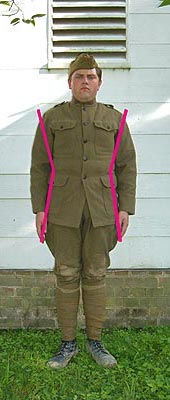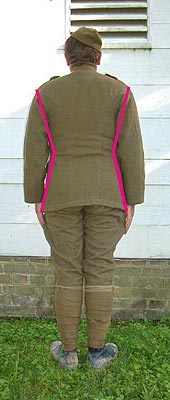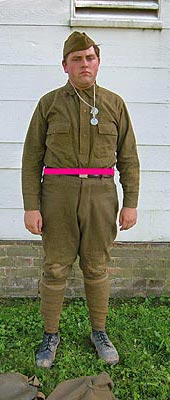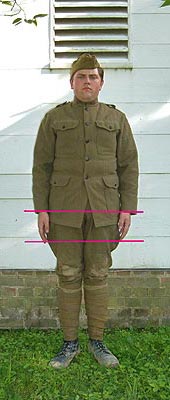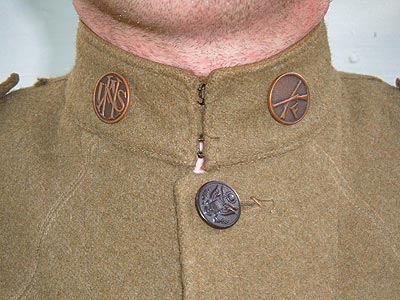


The Doughboy’s Uniform
The subject of uniforms of the American Expeditionary Forces can be quite an extensive topic. However, in this outline the focus will be on the uniform in relation to its fit and how the uniform should be worn by living historians portraying the American soldier of the First World War.
While not intended to address the various models of the uniform issued to the soldiers in France, it is nonetheless important to learn the characteristics of each of the uniform models issued to the AEF. The men of the 80th Division and all men of the AEF received the same uniforms. From both photographs and original identified uniforms, available in museums or on the collector market, it is known that the M1912 and M1917 uniforms, and the “rough cut” variation of the M1917 uniform were all commonly issued to the division. To learn more about the M1912, M1917, and the rough cut uniforms, the following sources are highly recommended –
“US Enlisted Uniforms 1900 – 1918” by Glenn E. Hyatt, which can be found at http://members.tripod.com/~Fbg_mem_museum/uniftalk/unipat1.htm. This is a three-part article and the links to each part may be found at the bottom of the page. It provides a good introduction to the evolution of uniforms in the early 20th century as well as descriptions of the characteristics of each of the uniform models.
“Uniforms of the Doughboy 1917-1918” By Luke Gammache, which can be found at http://www.angelfire.com/mb2/doughboy/index.html. Another good introduction the uniforms of the AEF. Includes descriptions of the 1912, 1917, rough-cut 1917, and the 1918. Includes photographs of each type of uniform showing details.
Over There! The American Soldier in World War I. By Jonathan Gawne. Published by Stackpole Books, Mechanicsburg, PA. ISBN 1-85367-268-8. This book is another good introduction to the uniform of the American soldier in WW1.
This original photograph is a great place to start as you learn about the uniform of the AEF. Probably made in 1919 of soldiers attending an army school, it serves as a good illustration of the soldier in his uniform. Within this photograph we will be able to see the different elements, that for the living historian, will create an accurate understanding of how it should fit and look.
Uniform Components
These two photographs illustrate the pieces that made up the uniform of the American soldier serving in France. The photo on the left shows our soldier wearing the issue shirt, breeches, puttees, overseas cap, and dogtags. The photo on the right shows the addition of the service coat. The uniform of the American soldier in France differed from that of the solder stateside, namely that the soldier serving in France was issued the leg wraps or “puttees” for wear, rather than the canvas leggings; and the overseas cap was issued instead of the M1911 campaign hat (Montana peak hat). The overseas caps were deemed easier to stow away when the helmet had to be worn.
One practice that seems to be common in the AEF and which we can see in the original photo is that of wearing the shirt collar exposed. Often the close fitting collar of the service coat would chafe the neck and the remedy was to pull out the shirt collar and wear it over the coat collar. We can see this in the original photo, 5th man from the left, second row.
The Fit of the Uniform
Take a moment to look back at the original photograph that we started with. As you look over the photograph, you will notice that a number of men are wearing uniforms that fit just right, while a number of other men are wearing uniforms that may either be too large or too small. It is correct and authentic to have a uniform that does not fit perfectly. The uniform was a ready made garment in general sizes and what you were issued is what you got. With this in mind though there are certain areas that in particular should stand out in regards to fit.
The first that that should stand out is that the cut and tailoring of the uniform creates an hourglass figure. The effect should generally be that of broad shoulders, narrow waist and wider hips or thighs as illustrated in our next two photos (notice the pink highlighting).
The next important feature to the fit of the uniform is the level of the waist. Late 20th and early 21st century fashion dictates that we today wear our pants at a lower point – on the hips – than the American soldier of the 19th and early 20th century. At that time the waistline was much higher than we are often accustomed to today.
The waistline of the early 20th century is the “natural waistline” or actual waist and is about the level of the navel or even near to the crook of the elbow as marked in the previous two photos.
The final area of fit is the “finished length.” This is length of the coat starting at the collar and finishing at the hem. The length should extend about 10-12 inches beyond the waistline. In general the finished length should fall somewhere between the wrist and the fingertips of the wearer as seen in this photo.
Position of the Collar Disk
This photo of the collar disks on the collar of the uniform is pretty self-explanatory if you are placing your collar disks. If you are looking at the tunic the “US” is placed on your left (which is the right side of the coat collar) and the branch of service disk is placed on your right (which is the left side of the coat collar).
Other than the collar disk and when acceptable rank chevrons, there are to be no decorations or awards worn on the uniform. Overall the uniform of the American soldier was rather plain and unadorned and we must reflect the same.
(a) Divisional insignia – Authorized in late October 1918, too late to be of wide issuance to the division
(b) Overseas chevrons – One chevron authorized for each 6-month period overseas. Most of the men of the division earned 2 chevrons, the first authorized December 1918/January 1919.
(c) Wound stripes – Awarded for each wounding event. These were awarded for actually being injured. If you have never shed your blood in service, it is highly inappropriate for you to wear one. The Purple Heart replaced the wound stripe in 1932.
(d) Awards of Valor – Awards for valor are the result of a soldier’s actions and brave deeds with a threat to life, and as such it is highly inappropriate for any such award to be worn. Historically most of these awards were not authorized until the summer of 1918 and not awarded for deeds of valor until post-Armistice.
(e) Campaign and marksmanship medals – The 80th Division was made up of men drafted into service and as such, it is highly unlikely that any of the men and line officers earned any of the pre-war campaign medals. While the division received marksmanship training, its qualification were not completed until April 1919, and as such, marksmanship medals are not to be worn.
It is very important to keep in mind that our impression is of the 318th Infantry during the Muse-Argonne Offensive (September-November 1918) and most of the awards and decorations would not be authorized until the period after the November 11, 1918 armistice.
Wearing the Helmet
When standing any formations or inspections, etc. The correct way to wear the helmet with the chin strap worn under the chin, helmet on straight. Wearing the helmet in this manner is correct and appropriate and heavily supported by photographic evidence. But once soldiers move into the front, he was very likely to move the chin strap for wear on the back of the head.
A few historians have put forth the theory that a soldier wearing a helmet with the chinstrap under his chin, was likely to receive a broken neck as the result of the concussion of artillery barrages knocking the helmet from his head. They believe that by moving the chinstrap to the back of the head, such injuries were not experienced, that the helmet was just knocked from the head. However, it is the belief of others that any soldier that close to artillery shells exploding, to have his neck broken by the chinstrap as the helmet is knocked off, is generally a dead soldier already. For all the good stories, we believe that the strap is worn on the back of the head for comfort and the quick and easy removal of the helmet for quicker donning of the gas mask.
Take these as you may but keep in mind, when standing formation, drills and inspections, chinstraps under the chin, and when going into the front chin strap on the back of the head.
Hopefully now you are better armed with the knowledge necessary to authentically wear the uniform of the WW1 American soldier.



